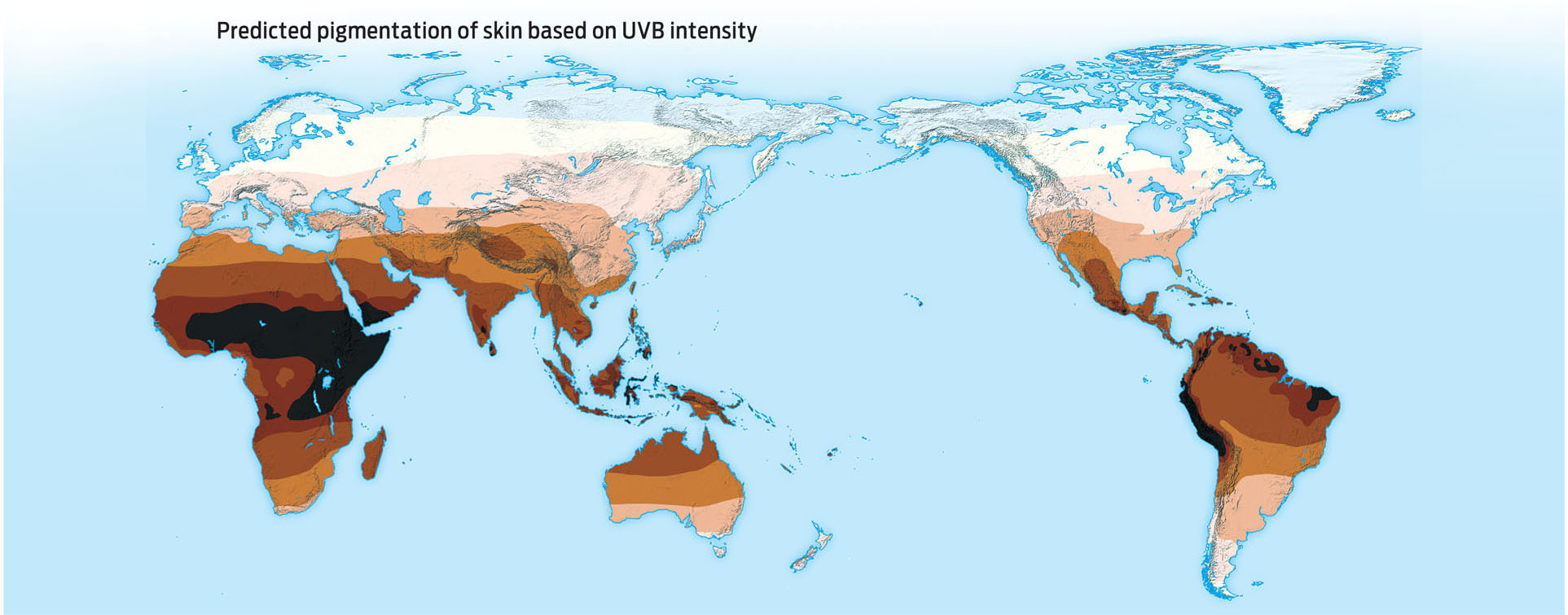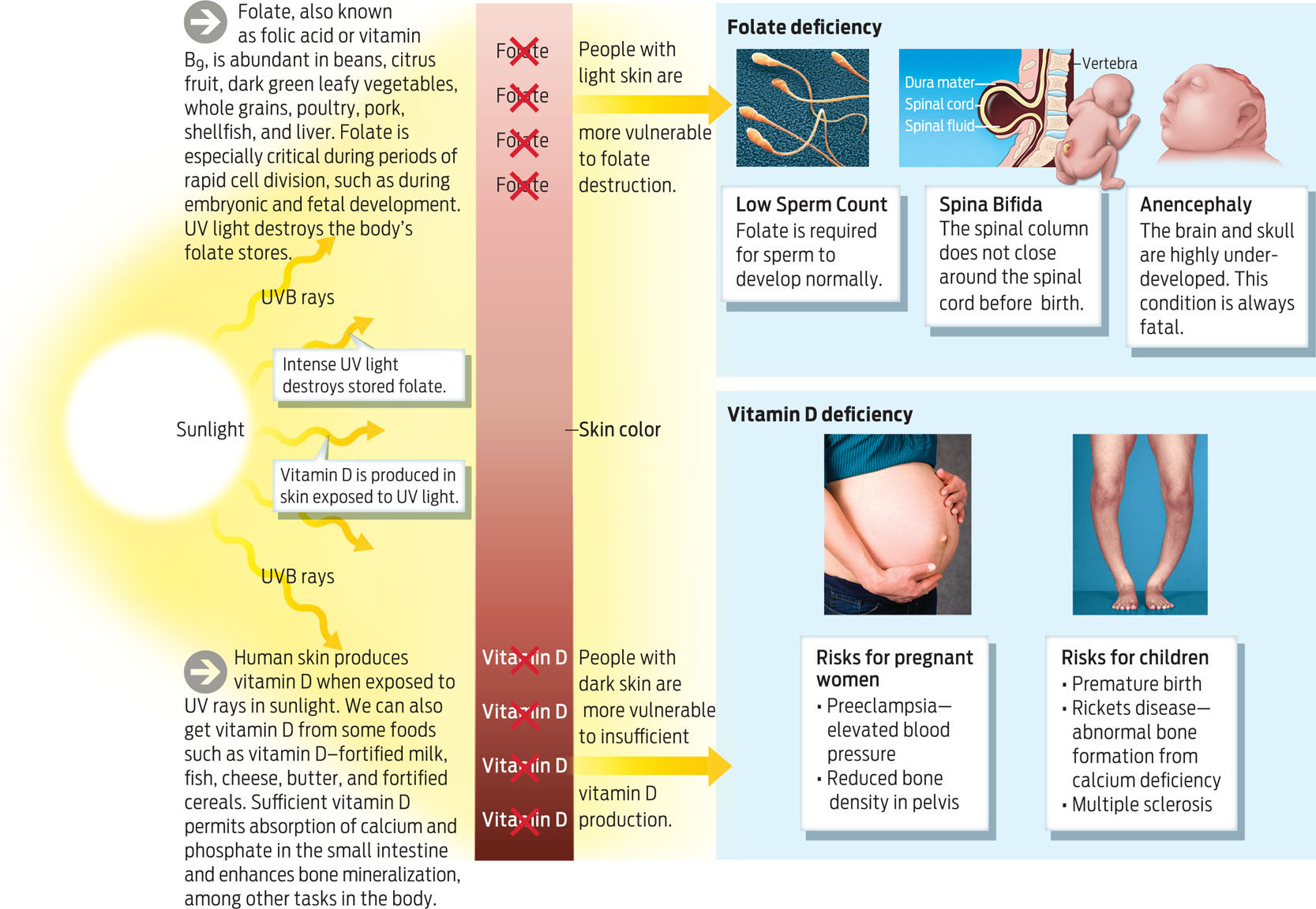THE EVOLUTION OF SKIN COLOR
MELANIN Pigment produced by a specific type of skin cell that gives skin its color.
More than a decade ago, Jablonski and her husband, George Chaplin, a geographic information systems specialist, set out to understand why human populations evolved varying skin tones. They knew that skin tone largely reflects the amount of melanin present in the skin. People naturally produce different levels of melanin: more melanin yields darker skin, less melanin lighter skin. Skin also responds to sunlight by producing more melanin and becoming darker temporarily (INFOGRAPHIC 20.2).
Melanocytes are a type of cell located in the epidermis, the outermost layer of skin. Melanocytes make the pigment melanin and deposit it into other cells in the skin. A person’s skin color depends largely on the amount and type of melanin that his or her skin melanocytes produce. Sunlight can also temporarily increase the amount of melanin in a person’s skin.

Jablonski and Chaplin also knew that, in general, skin tone correlates with geography: people from regions closer to Earth’s poles tend to be lighter-skinned and those from areas closer to the equator tend to have darker skin. Jablonski wanted to understand this, so she searched the scientific literature. Might there be an evolutionary advantage to having light or dark skin in different environments?

FOLATE A B vitamin also known as folic acid, folate is an essential nutrient, necessary for basic bodily processes such as DNA replication and cell division.
She found her first clue in a 1978 study showing that an hour of intense sunlight can halve the level of an important vitamin known as folate in light-skinned people. Folate, also called folic acid, is an essential nutrient, necessary for basic bodily processes like DNA replication and cell division.
Then, at a seminar, Jablonski learned that low folate levels can cause severe birth defects such as spina bifida—a condition in which the spinal column does not close—and anencephaly, the absence at birth of all or most of the brain. She subsequently came across three case studies that linked such birth defects to the mothers’ visits to tanning studios, where the women would have been exposed to ultraviolet light. She also learned that folate is necessary for the normal development of sperm.

Taken together, these observations suggested to Jablonski that people with light skin are more vulnerable to folate destruction than are darker-skinned people—presumably because melanin absorbs damaging UV light and dissipates it as heat. Could the need to protect the body’s folate stores from UV light have driven the evolution of darker skin shades? The supporting evidence was compelling. But then what was the advantage of having light skin at all, as many populations today do?
Jablonski considered a hypothesis first proposed in the 1960s by biochemist W. Farnsworth Loomis, who suggested that vitamin D might play a role in the evolution of skin color. Unlike folate, which is destroyed by excess sunlight, the production of vitamin D requires ultraviolet light. Vitamin D is crucial for good health: it helps the body absorb calcium and deposit it in bones. During pregnancy women need extra vitamin D to nourish the growing embryo. And because vitamin D is so important for healthy bone growth, too little might cause bone distortion, and a distorted pelvis would make it difficult for a woman to bear children (INFOGRAPHIC 20.3).
Building on this previous work, in 2000 Jablonski and Chaplin compared data on skin color in indigenous populations from more than 50 countries to levels of global ultraviolet light as measured by NASA satellites. They found a clear correlation: the weaker the ultraviolet light, the fairer the skin—a compelling suggestion that both dark and light skin are linked to levels of global sunlight. They published their results in the Journal of Human Evolution.
The researchers now had a complete hypothesis: light skin evolved in sun-poor parts of the world because it helped the body produce vitamin D, while dark skin evolved because it helped protect the body’s folate stores in people who lived in sunny climates. The body’s need to balance levels of these two important nutrients given varied levels of UV light explains why there is so much variation in skin tone around the globe (INFOGRAPHIC 20.4).
Nina Jablonski and George Chaplin used NASA satellite measurements of UVB intensity to predict the amount of skin pigment that would best block harmful UV rays yet still enable the body to produce sufficient vitamin D in populations around the globe. Their predictions closely match actual skin color variations around the world.

Since the publication of Jablonski and Chaplin’s work, many other scientists have tested their hypothesis, and it is now the most widely accepted explanation for the evolution of human skin color. As Jablonski points out, “It synthesizes the available information on the biology of skin from anatomy, physiology, genetics, and epidemiology, and has not been contradicted by any subsequent data.”
